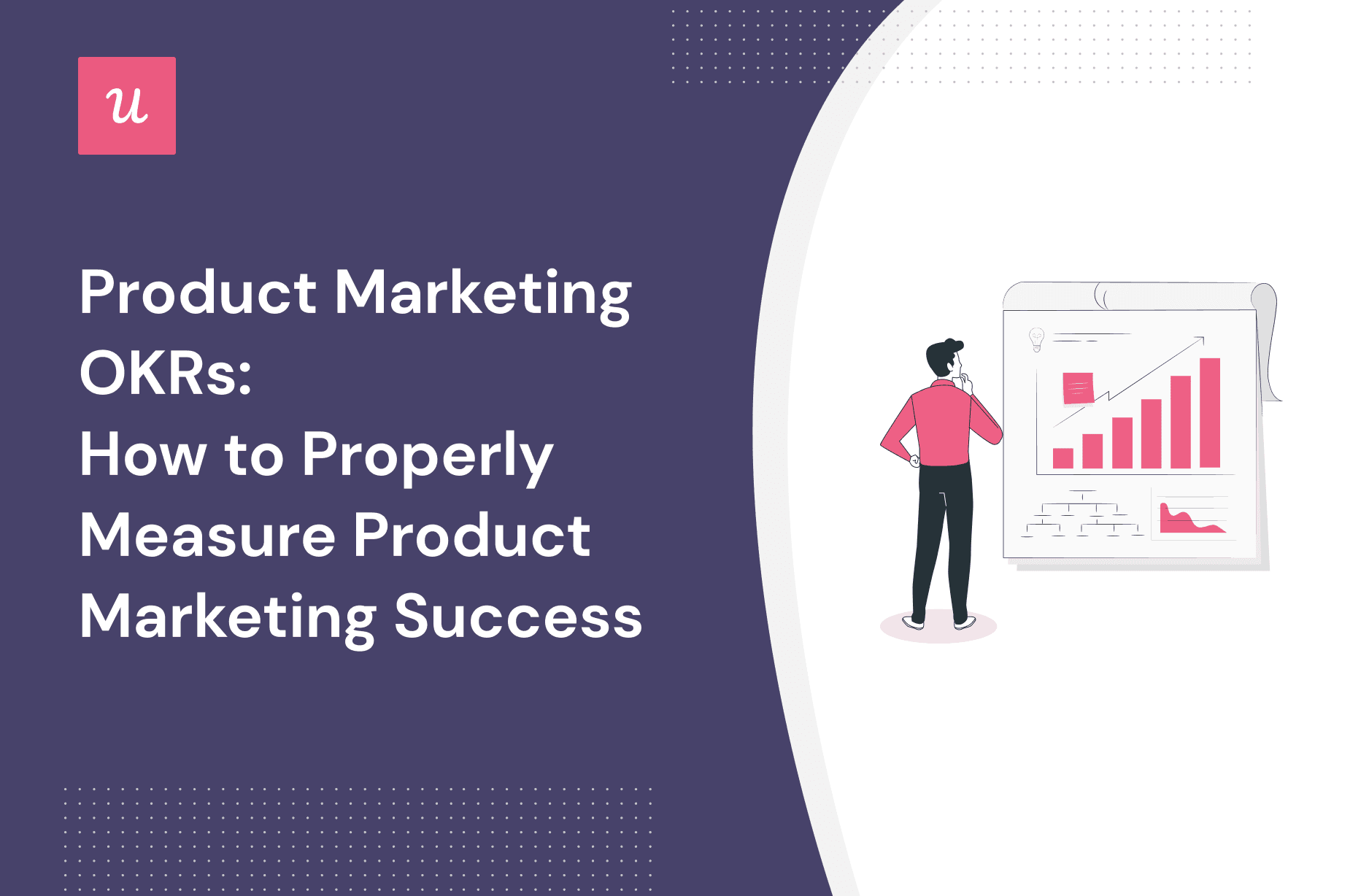
Product Marketing OKRs: How to Properly Measure Product Marketing Success
Try Userpilot Now
See Why 1,000+ Teams Choose Userpilot

What are product marketing OKRs (Objectives & Key Results)?
Product marketing OKRs (objectives and key results) are the goals you set for your product marketing efforts. They also include the progress milestones that measure if you’re on track to achieving them.

Product marketing OKRs vs KPIs
There are two main performance frameworks in product marketing – OKRs and KPIs.
OKR is a larger framework of objectives and goals that guides strategy. Meanwhile, a KPI is a single metric that gives a reflection of performance in one area.
KPI goals are the product of an existing process and are used to measure the success of that process. OKR goals differ in that they’re more of a strategy itself, with the objective at the top, and their key results that measure progress.

Why are OKRs important?
OKRs are important in product marketing because of four reasons:
Establish a solid foundation for the product marketing process
Choosing what to focus on is one of the biggest challenges that OKRs solve for product marketing teams.
They help guide your product marketing strategy and help you break down larger business goals into clear-cut processes. They’re also designed to measure progress along the way. You can find opportunities to improve and pivot your strategy whenever needed.
Bring the clarity for achieving a company-level goal
OKRs are set company-wide, so the entire team is focused on a clearly defined common goal. After the overall OKRs are set, individual departments then set their objectives and key results to achieve that bigger goal.
Motivate your product marketing team
Purpose and direction drive motivation. When your marketing team knows exactly what they’re doing and why they feel motivated to be part of something bigger and face less resistance in their work.
Controlled autonomy
When you’ve successfully created an OKR strategy, your goals are clear and updates are happening weekly.
Progress is visible. You can see where your wins are and where help is needed.
Different types of product marketing OKRs
Four types of OKRs cater to different goals:
Go-to-market OKRs
Go-to-market OKRs are centered around positioning and marketing a product to the target market.
Objectives include (but are not limited to):
- Achieving product-market fit
Product-market fit helps you determine if you are in the right market. You can identify product-market fit with PMF surveys.

- Increase sales performance and win rates
Win rate OKRs measure sales performance by showing how many deals were closed compared to the number of inbound leads or conversations. Marketing should bring in high-quality monthly leads to get more sales, and the sales team needs to successfully close the deal.
- Increase conversion rate OKRs
Conversion rate measures what percentage of customers and current customers are progressing through the stages of the marketing funnel.
- Grow the average deal size
Average deal size indicates how much an individual customer is spending when they purchase from your business.
Product adoption OKRs
Product adoption OKRs revolve around getting more customers to increase product use, both in frequency and in range (ie. using a new feature).
They include (but aren’t limited to):
- Increase active users
How many customers are using your app frequently? You can use MAU, DAU, and WAU to measure active users in a given period.
- Increase user satisfaction
You can measure user satisfaction with in-app surveys that ask customers directly how satisfied they are with their experience of your product or with a specific element (like a feature).

- Drive higher retention
Retention OKRs aim to measure and improve churn, renewal rates, and retention rates, getting users to keep paying for a product or service for as long as possible.
- Increase feature adoption
OKRs surrounding feature adoption measure how users are discovering and using product features. The aim is to get more users to use most or all the features available in the app.

- Increase upsell and cross-sell revenue
Expansion revenue OKRs aim to measure and improve the rate of up-sells and cross-sells, boosting customer lifetime value.
- Decrease time to value and task completion time
OKRs that optimize the time taken to complete actions help to overcome product friction and improve a product’s perceived value.
Sales enablement OKRs
Sales enablement OKRs aim to get more sales and revenue through the door.
Objectives include, but are not limited to:
- Increase sales confidence
Are sales reps entering sales conversations confident that they can close? If not, why?
It could be a case of poor leads or the absence of the right resources or assets to support conversation or your product may be missing an important feature your sales can’t rely on.
- Improve sales velocity
How fast do new leads turn into confirmed deals? Sales velocity OKRs measure and improve the speed of acquiring new leads and closing them.
Lead/demand-gen OKRS
Lead and demand-gen OKRs give product marketers a data-informed strategy for bringing in new leads.
Objectives include, but are not limited to:
- Improve campaign performance
How well are new ad campaigns performing? Or PPC campaigns? Is social media engagement high? Is the content strategy contributing to new revenue?
These questions revolve around campaign performance OKRs and are intended to help businesses reach their marketing goals.
- Increase the number of leads generated by PMM content
How many leads is the product marketing team bringing in? Are they converting?
- Build brand awareness
Brand awareness OKRs guide the strategy for overall brand recognition. Do most people know about your business and understand what you do? If not, you need to boost awareness.
How do you write OKRs for a product?
Write OKRs for your product with this easy formula:
“We will [Objective] as measured by [Key Results]”
Objectives answer: “What do I want to achieve?” Key Results answer: “How do I know that the goal is achieved?”.
Objectives must be qualitative, easy to understand, and inspiring. Key Results should be measurable, outcome-driven (not output-driven), and follow the S.M.A.R.T. goal-setting framework.

What are some good product marketing OKRs?
Here are three product marketing OKR examples that can help drive faster growth:
Objective: Turn new and existing users into active users of your product
Acquiring new paid customers is only the first part of sustainable growth. You also have to increase user engagement to boost retention and avoid churn.
That’s the objective of this OKR.
Key results can be:
- Increase activation rate by 10%
- Grow Monthly Active Users (MAU) by 12%
- Increase 30-day retention rate to 98%
- Improve trial account to paid account conversions by 20%
To help new users experience value faster, personalize their product experience from day one. Use an onboarding survey to learn relevant information about their role and jobs to be done during the onboarding process so you can offer them the most relevant guidance.

To increase customer lifetime value, find upselling opportunities. Offering trials to premium features is a great upselling strategy. Once customers experience the value of the paid features first-hand, they’ll be more likely to upgrade at the end of the trial.
In this example from Asana, they let their users’ test drive their Goals feature, which is normally only available for premium accounts.

Objective: Drive retention and increase the lifetime value
Customer acquisition is more expensive than retaining an existing customer. You can see why setting an OKR to boost retention and lifetime value is key to sustainable product growth.
Key results can be:
- Improve retention by 8%
Subscription marketing refers to the goal of acquiring loyal customers who purchase a subscription for a recurring fee.
You can use loyalty programs to improve customer retention and boost customer acquisition. This way, they will be more likely to have a positive experience and stick around.
For example, Dropbox gifts customers free storage space in exchange for referrals.

- Increase satisfied customers by 2x
Satisfied customers become loyal customers. You can measure customer satisfaction with the net promoter score (NPS surveys), coupled with follow-up questions. Using this data, you can make necessary changes to increase customer satisfaction.

Objective: Map the customer journey and understand product usage
One way to increase user engagement is to better understand product usage so you can eliminate any friction.
Set an OKR to map the customer journey and track product usage along the journey.
Key results can be:
- Conduct 10 user interviews with the target audience
The best way to understand customers is to speak to them 1-to-1. Entice users to interview by offering them a small gift.

- Map the product features to the user journey
Find out what features existing customers are turning to in their journey, from when they first onboard to when they become an advocate.

- Validate customer journey mapping with your target audience
While user journey mapping is a useful tool to visualize the customer experience, it’s only helpful if it’s accurate. Validate your map by comparing it to the experience that your customers have.
Best practices of product marketing OKRs
Keep these best practices in mind when writing your OKRs:
Objectives are clear and easy to understand
Make sure your objectives are as clear as day. Take them down to their simplest form so there are no misunderstandings.
Objectives are public to your company
Make objectives visible, even between departments. The product marketing team should understand what the engineering team is working on, and vice versa. Everyone in the company should be aligned and working toward a common goal.
This helps to avoid information silos and miscommunication.
You regularly measure performance
Track your progress every step of the way. Set up a metric to measure your team’s performance.
You are prepared to fail
OKRs are especially useful because of continuous tracking. When you set an objective and monitor progress along the way, you can recognize when a strategy or tactic is failing before you waste too much time or money on it.
OKRs help you assess and pivot quickly. That being said, you have to be adaptable and open to recognizing and acting on failure.
How Userpilot can help you with your product marketing OKRs
Userpilot is a product growth platform that helps you build personalized in-app experiences and track product usage, code-free.
Create goals and measure OKRs’ performance
When you write your OKRs, you can create matching goals in Userpilot and automatically measure progress. Keep a close eye on what’s working and what’s not so you can make better product improvements.

Track OKR progress with analytics
With Userpilot’s product usage analytics, you can track what features your customers are using and how they’re progressing toward your set goals.
This helps you identify areas for improvement, such as high-friction points or underused features.

Conclusion
OKRs are the key to building a successful strategy that brings in more paying customers.
Want to get started with tracking OKRs? Get a Userpilot Demo and see how you can set goals and measure progress, code-free.






